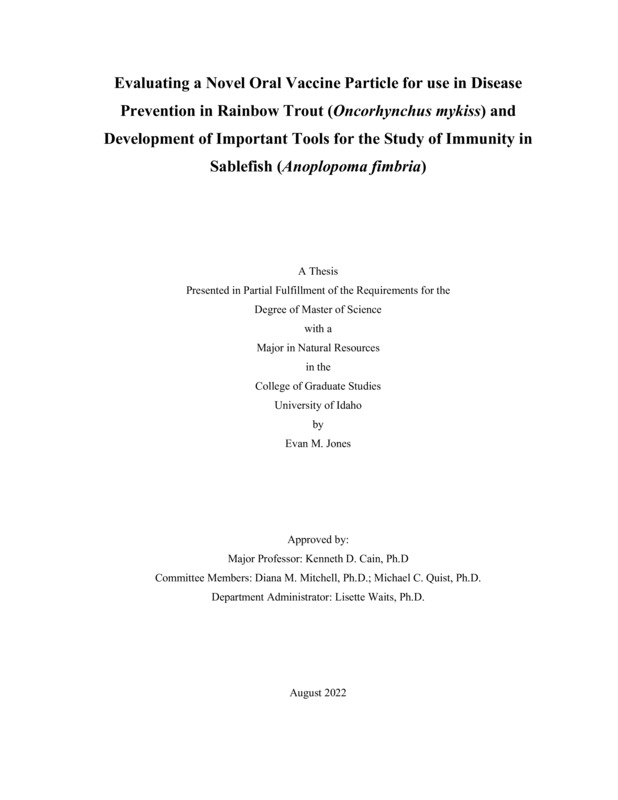Evaluating a Novel Oral Vaccine Particle for use in Disease Prevention in Rainbow Trout (Oncorhynchus mykiss) and Development of Important Tools for the Study of Immunity in Sablefish (Anoplopoma fimbria)
Jones, Evan. (2022-08). Evaluating a Novel Oral Vaccine Particle for use in Disease Prevention in Rainbow Trout (Oncorhynchus mykiss) and Development of Important Tools for the Study of Immunity in Sablefish (Anoplopoma fimbria). Theses and Dissertations Collection, University of Idaho Library Digital Collections. https://www.lib.uidaho.edu/digital/etd/items/jones_idaho_0089n_12409.html
- Title:
- Evaluating a Novel Oral Vaccine Particle for use in Disease Prevention in Rainbow Trout (Oncorhynchus mykiss) and Development of Important Tools for the Study of Immunity in Sablefish (Anoplopoma fimbria)
- Author:
- Jones, Evan
- Date:
- 2022-08
- Keywords:
- aeromonas salmonicida aquaculture monoclonal antibody oral vaccine rainbow trout sablefish
- Program:
- Fish & Wildlife Sciences
- Subject Category:
- Aquatic sciences; Immunology; Veterinary science
- Abstract:
-
Vaccination is an important tool in preventing diseases in animals and humans. As the aquaculture industry has grown, so too has the demand for efficacious and efficient vaccination strategies. Vaccines in aquaculture are mainly administered by injection or immersion, with relatively few exceptions for orally administered vaccines against enteric pathogens. Oral vaccines encounter several problems associated with their delivery but most important may be the degradation during intestinal travel. A novel alginate-based oral vaccine delivery platform was developed by researchers at Oregon State University (OSU) that is designed to protect vaccine antigens during gastrointestinal travel. In cooperation with the National Oceanic and Atmospheric Administration (NOAA) and OSU, this project evaluated the ability of this oral vaccine platform to induce a specific immune response and provide protection against Aeromonas salmonicida, the causative agent of furunculosis, when fed to rainbow trout (Oncorhynchus mykiss). The immune response and efficacy of a simple formalin killed A. salmonicida vaccine was tested by using comparing routes of immunization in rainbow trout: intraperitoneal injection, immersion, anal intubation, and the experimental oral vaccine particle. Fish were given a booster dose of vaccine using the same protocols 2 weeks after the initial dose. Rainbow trout were then challenged with the virulent A. salmonicida strain that was used for vaccine development. Results show that intraperitoneal injection induced the highest level of specific antibodies out of all treatments, and protection was significantly higher than other vaccination routes only after Freund’s adjuvant was included with injections. Immersion and anal intubation treatments produced similar levels of both specific antibodies and protection against pathogen challenge. The novel oral vaccine particle successfully stimulated antibody production and provided significant short term protection, but insignificant long term protection during a pathogen challenge. Interestingly, fish fed the novel alginate particle without vaccine showed reduced disease related mortality, indicating a potential adjuvant effect of the particle formulation itself. Beyond the vaccine study in rainbow trout, parallel studies in sablefish (Anoplopoma fimbria) at OSU and NOAA were underway. To assist in evaluation of an immune response in this species, a monoclonal antibody (mAb) specific to sablefish Immunoglobulin M (IgM) was also developed as a tool to measure the immune response when vaccinated with similar alginate particle vaccines. This mAb , known as UI-25A, was created using mice and recognizes the conserved heavy chain of sablefish IgM. UI-25A is highly specific to sablefish IgM and lacks any reactivity to blood antigens of rainbow trout, Atlantic salmon (Salmo salar), coho salmon (Oncorhynchus kisutch), or burbot (Lota lota) as well as antigens found in lysed preparations of A. salmonicida. Using UI-25A, an enzyme linked immunosorbent assay (ELISA) was developed to measure specific antibodies in plasma of vaccinated sablefish. This ELISA was successful at differentiating between vaccinated and unvaccinated sablefish based on the level of antibody titers from each group. UI-25A was further characterized and used to visualize immunogenic antigens in western blot analysis for both whole cell protein profiles and isolated lipopolysaccharide of A. salmonicida. Further, immunofluorescent staining of head kidney tissue imprints showed that UI-25A could detect membrane bound IgM on the surface of B-cells. These applications of the UI-25A mAb demonstrate its broad applicability to aid research into sablefish immunology.
- Description:
- masters, M.S., Fish & Wildlife Sciences -- University of Idaho - College of Graduate Studies, 2022-08
- Major Professor:
- Cain, Kenneth D
- Committee:
- Mitchell, Diana M; Quist, Michael C; Waits, Lisette
- Defense Date:
- 2022-08
- Identifier:
- Jones_idaho_0089N_12409
- Type:
- Text
- Format Original:
- Format:
- application/pdf
- Rights:
- In Copyright - Educational Use Permitted. For more information, please contact University of Idaho Library Special Collections and Archives Department at libspec@uidaho.edu.
- Standardized Rights:
- http://rightsstatements.org/vocab/InC-EDU/1.0/

